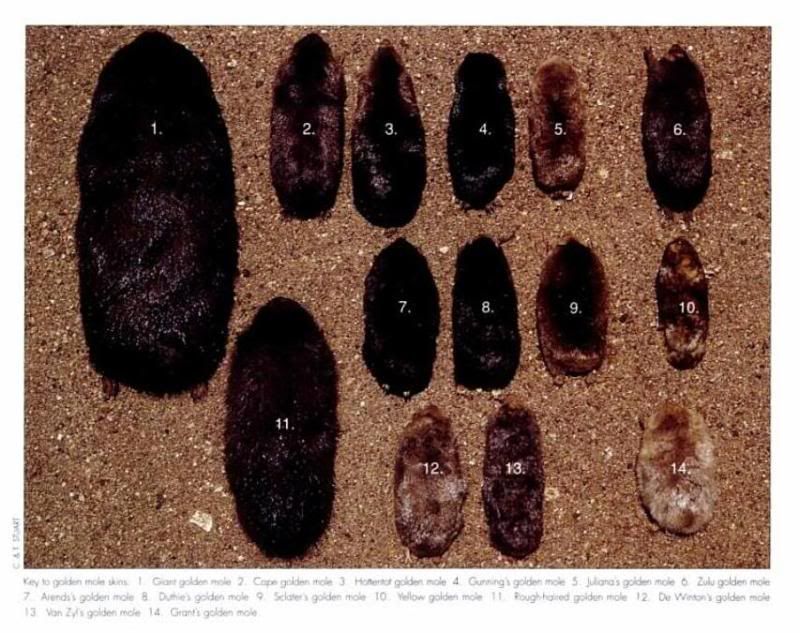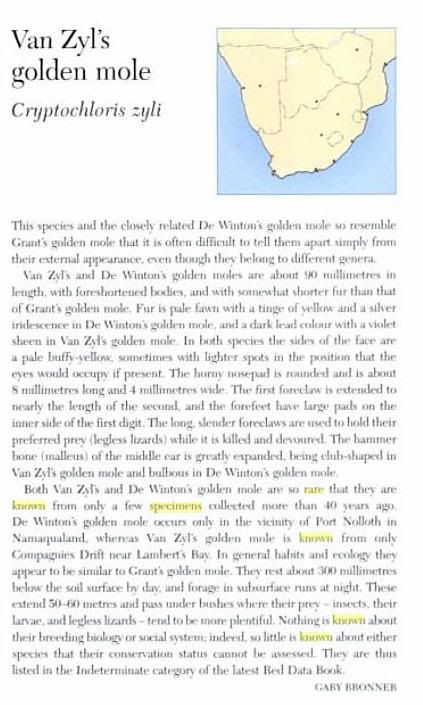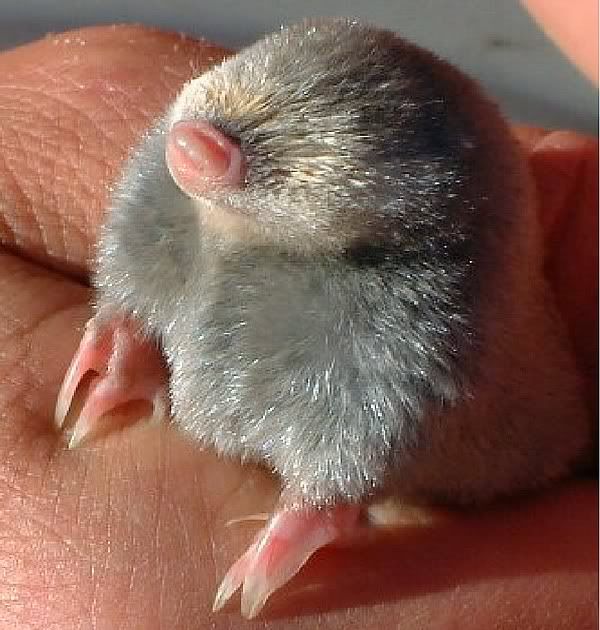Post by Melanie on Dec 6, 2008 18:26:37 GMT
Cryptochloris zyli
Additional material of the enigmatic golden mole
Cryptochloris zyli, with notes on the genus
Cryptochloris (Mammalia: Chrysochloridae)
K.M. Helgen1 & D.E. Wilson2
Mammal Department, Museum of Comparative Zoology, Harvard University, Cambridge, MA 02138, U.S.A.
E-mail: helgen@fas.harvard.edu
Division ofMammals, National Museum ofNatural History, Smithsonian Institution, Washington, DC 20560, U.S.A.
Received 21 July 2000. Accepted 24 November 2000
Van Zyl's golden mole (Cryptochloris zyli) is a distinctive
but little-known species from the northwestern
Cape Province of South Africa. Many authors have
mentioned that it is known only by the holotype. Two
other specimens are now known to exist; one was
discovered in the Museum of Comparative Zoology at
Harvard University, and the other, which has been
mentioned in publication but overlooked, is in the
Natural History Museum in London. Differentiation of C. zyli from sympatric chrysochlorids, and from its
congener C. wintoni, are discussed.
Keywords: Chrysochloridae, systematics, South Africa.
In 1938 G.C. Shortridge and T.D. Carter named a
new genus and species of golden mole, Cryptochloris
zyli, based on a single specimen collected by
Gideon van Zyl. This specimen, an adult
male with original number 3477, was collected on 13 January 1937 at Compagnies Drift, '10 miles
[16.1 km] inland from Lamberts Bay', in the northwestern
Cape Province (Shortridge & Carter 1938:
284). The holotype is number 837 in the collections
of the Amathole Museum (AM), King William's
Town, South Africa. Most recent authors recognize
C. zyli as a valid species (Hutterer 1993; Meester
1974; Meester et al. 1986; Nowak 1999; Skinner &
Smithers 1990), noting that it is known only by a
single specimen. The genus Cryptochloris also contains
the species C. wintoni (Broom, 1907), known
from only a few specimens.
A second specimen of C. zyli, represented by skin
and skull, exists in the Museum of Comparative
Zoology (MCZ) at Harvard University. The
unsexed specimen, MCZ 39628, was collected by
Van Zyl in January 1938 at the type locality and
bears the original number 3650; it was originally
identified by G.C. Shortridge. The original label
designates this specimen as a paratype, although
the type description mentions that only one specimen
was collected. No field measurements are
available for MCZ 39628; Van Zyl noted on the tag
that it was collected at an approximate altitude of
100 feet (= 30.5 m).
Unfortunately, the cranium of MCZ 39628 is
fragmented posterior to the frontals; the palate
and maxillary dentition are, however, fully intact.
Of the cranial measurements included in the
original description of C. zyli, only the length of
the maxillary tooth row from incisor to posterior
molar (9.4 mm), and the posterior width of the
palate (6.0 mm), can be made for this specimen.
In addition, Simonetta (1968) referred to and
provided a detailed illustration of the skull of
another specimen of C. zyli, number 49-240 in the
Natural History Museum, London (formerly
AM 842). This specimen, also designated as a
paratype, was collected 28 March 1938 at the
type locality, also by Gideon van Zyl. Like the
MCZ 'paratype,' the specimen was collected at an
approximate altitude of 100 ft (= 30.5 m). Measurements
for the London specimen are as follows:
greatest length of skull, 21.7 mm, palatal breadth
(across posterior molars), 7.8 mm, maxillary tooth
row (excluding incisors), 8.0 mm.
In addition to C. zyli, two other species of golden
mole are known from Compagnies Drift, Cape
Province - Grant's golden mole (Eremitalpa granti),
and the Cape golden mole (Chrysochloris asiatica).
The former species is easily distinguishable
from Cryptochloris by its lack of iridescent pelage
and absence of temporal bullae (Nowak 1999).
Distinguishing Chrysochloris and Cryptochloris is
more difficult, but relative to Chrysochloris,
Cryptochloris has a better developed first digit of
the manus, lighter pelage with a more silvery
ventrum, greater frontal expansion of the cranium
and smaller temporal bullae. In addition, the
second upper incisor in Chrysochloris is markedly
larger than the third incisor and canine, while the
difference in the comparative size of all three teeth
is much less noticeable in Cryptochloris. Most of
these differences are illustrated well in Simonetta
(1968), and are also evident when comparing the
MCZ specimen with the series of Chrysochloris
asiatica in that museum, also collected at
Compagnies Drift by Van Zyl in 1938.
Some confusion has existed since the description
of C. zyli regarding the proper classification of
wintoni and zyli, the two named forms of
Cryptochloris. Early revisions after Shortridge &
Carter (1938) included both as subspecies of the
single species C. wintoni (Ellerman et al. 1953;
Simonetta 1968), but, as mentioned above, recent
systematic accounts have accorded specific status
to both forms. This latter arrangement is based
on several supposed morphological differences
between the two. Ellerman et al. (1953: 39) suggested
that zyli has a slightly larger and narrower
skull than wintoni'. We have not observed enough
specimens to comment on the validity of this
claim. Meester (1974) noted that the malleus, an
important character in chrysochlorid systematics
(Cooper 1928; Simonetta 1957), is more elongate in
zyli and more bulbous in wintoni. This observation
is presumably based on an examination of the
Amathole specimen of C. zyli, but cannot be
supported by the MCZ specimen, due to the fragmentation
of the cranium. Simonetta (1968: 40)
noted that the specimen of zyli in London has a
malleus smaller, but as club-shaped as C[hrysochloris]
asiatica,' but as he had observed no specimens
he could refer to wintoni, he was unable to
comment on the purported differentiation of the
malleus between the two forms.
The most noticeable difference between zyli and
wintoni is their contrasting external colouration
and iridescence. C. zyli is darker and more brown
than C. wintoni, and has a purplish iridescence
whereas in wintoni the iridescence is more silvery,
as recorded by Skinner & Smithers (1990). Although
the observations of those authors were apparently
again based solely on the Amathole
specimen of zyli, the additional specimens uphold
this distinction. In both additional specimens of zyli, at Harvard and London, the pelage is brown
with a notable purplish iridescence on the dorsum,
with a paler ventrum and buffy white markings
on the face, exactly as originally described by
Shortridge and Carter. It is noticeably darker than
the specimen of C. wintoni (United States National
Museum, number 468319) thatwe have examined.
These additional specimens described here,
which appear to have been wholly or largely overlooked
by researchers, greatly increase the
amount of available material that can be referred
to Cryptochloris zyli, and may serve to provide
valuable insight into the systematics of this littleknown
genus and species. A more elaborate investigation,
bringing together these three specimens
with all known material referable to C. wintoni,
would probably conclusively establish the proper
relationship of these two forms with each other. In
addition, such an investigation would probably
clarify the relationship of Cryptochloris to other
chrysochlorid genera, especially Chrysochloris, of
which it is occasionally considered a subgenus. In
light of these additional specimens, and through
comparison with other chrysochlorids of the
southern African region, we feel it is best to
continue to recognize Cryptochloris as a distinctive
genus, consisting of two species, each known at
present from extremely narrow geographical
ranges in the coastal sand dunes of southwestern
Africa.
We are thankful to C.T. Chimimba, L. Claessens, and
two reviewers for their comments in preparing this
manuscript, and to M. Rutzmoser of the MCZ.
REFERENCES
COOPER, C.F. 1928. On the ear region of certain of the
Chrysochloridae. Philosophical Transactions of the Royal
Society of London (B) 216: 265-283.
ELLERMAN, J.R., MORRISON-SCOTT, T.C.S. & HAYMAN,
R.W. 1953. Southern African Mammals 1758 to
1951. British Museum (Natural History), London.
HUTTERER, R. 1993. Order Insectivora. In: Mammal
Species of the World: A Taxonomic and Geographic
Reference, (eds) D.E. Wilson & D.R. Reeder, 2nd edn,
pp. 69-130. Smithsonian Institution Press, Washington,
D.C.
MEESTER, J.A.J. 1974. Order Insectivora, Family
Chrysochloridae. In: The Mammals ofAfrica: An Identification
Manual, (eds) J. Meester &HW Setzer, Part 1.3,
pp. 1-7. Smithsonian Institution, Washington, D.C.
MEESTER, J.A.J., RAUTENBACH, I.L., DIPPENAAR,
N.J., & BAKER, CM. 1986. Classification of southern
African mammals. Transvaal Museum Monographs 5:
1-359.
NOWAK, R.M. 1999. Walker's Mammals of the World, 6th
edn. )ohns Hopkins University Press, Baltimore.
SIMONETTA, A. 1957. Anatomia e significato
morfologico e sistematico dell'orecchio medio e delle
strutture ad esso connesse in alcuni insettivori
(Suncus, Talpa, Chrysochloris). Archivio Italiano di
Anatomia e di Embriologia 62: 55-94.
SIMONETTA, A.M. 1968. A new golden mole from
Somalia with an appendix on the taxonomy of the
family Chrysochloridae (Mammalia: Insectivora).
Monitore Zoologico italiano 2 (suppl.): 27-55.
SHORTRIDGE, G.C. & CARTER, T.D. 1938. A new genus
and new species and subspecies of mammals from
Little Namaqualand and the north-west Cape Province;
and a new subspecies of Gerbillus paeba from the
eastern Cape Province. Annals of the South African
Museum 32: 281-291.
SKINNER, J.D. & SMITHERS, R.H.N. 1990. Mammals of
the Southern African Subregion, 2nd edn. University of
Pretoria, Pretoria.
si-pddr.si.edu/dspace/bitstream/10088/4695/1/VZ_dew1.pdf
Additional material of the enigmatic golden mole
Cryptochloris zyli, with notes on the genus
Cryptochloris (Mammalia: Chrysochloridae)
K.M. Helgen1 & D.E. Wilson2
Mammal Department, Museum of Comparative Zoology, Harvard University, Cambridge, MA 02138, U.S.A.
E-mail: helgen@fas.harvard.edu
Division ofMammals, National Museum ofNatural History, Smithsonian Institution, Washington, DC 20560, U.S.A.
Received 21 July 2000. Accepted 24 November 2000
Van Zyl's golden mole (Cryptochloris zyli) is a distinctive
but little-known species from the northwestern
Cape Province of South Africa. Many authors have
mentioned that it is known only by the holotype. Two
other specimens are now known to exist; one was
discovered in the Museum of Comparative Zoology at
Harvard University, and the other, which has been
mentioned in publication but overlooked, is in the
Natural History Museum in London. Differentiation of C. zyli from sympatric chrysochlorids, and from its
congener C. wintoni, are discussed.
Keywords: Chrysochloridae, systematics, South Africa.
In 1938 G.C. Shortridge and T.D. Carter named a
new genus and species of golden mole, Cryptochloris
zyli, based on a single specimen collected by
Gideon van Zyl. This specimen, an adult
male with original number 3477, was collected on 13 January 1937 at Compagnies Drift, '10 miles
[16.1 km] inland from Lamberts Bay', in the northwestern
Cape Province (Shortridge & Carter 1938:
284). The holotype is number 837 in the collections
of the Amathole Museum (AM), King William's
Town, South Africa. Most recent authors recognize
C. zyli as a valid species (Hutterer 1993; Meester
1974; Meester et al. 1986; Nowak 1999; Skinner &
Smithers 1990), noting that it is known only by a
single specimen. The genus Cryptochloris also contains
the species C. wintoni (Broom, 1907), known
from only a few specimens.
A second specimen of C. zyli, represented by skin
and skull, exists in the Museum of Comparative
Zoology (MCZ) at Harvard University. The
unsexed specimen, MCZ 39628, was collected by
Van Zyl in January 1938 at the type locality and
bears the original number 3650; it was originally
identified by G.C. Shortridge. The original label
designates this specimen as a paratype, although
the type description mentions that only one specimen
was collected. No field measurements are
available for MCZ 39628; Van Zyl noted on the tag
that it was collected at an approximate altitude of
100 feet (= 30.5 m).
Unfortunately, the cranium of MCZ 39628 is
fragmented posterior to the frontals; the palate
and maxillary dentition are, however, fully intact.
Of the cranial measurements included in the
original description of C. zyli, only the length of
the maxillary tooth row from incisor to posterior
molar (9.4 mm), and the posterior width of the
palate (6.0 mm), can be made for this specimen.
In addition, Simonetta (1968) referred to and
provided a detailed illustration of the skull of
another specimen of C. zyli, number 49-240 in the
Natural History Museum, London (formerly
AM 842). This specimen, also designated as a
paratype, was collected 28 March 1938 at the
type locality, also by Gideon van Zyl. Like the
MCZ 'paratype,' the specimen was collected at an
approximate altitude of 100 ft (= 30.5 m). Measurements
for the London specimen are as follows:
greatest length of skull, 21.7 mm, palatal breadth
(across posterior molars), 7.8 mm, maxillary tooth
row (excluding incisors), 8.0 mm.
In addition to C. zyli, two other species of golden
mole are known from Compagnies Drift, Cape
Province - Grant's golden mole (Eremitalpa granti),
and the Cape golden mole (Chrysochloris asiatica).
The former species is easily distinguishable
from Cryptochloris by its lack of iridescent pelage
and absence of temporal bullae (Nowak 1999).
Distinguishing Chrysochloris and Cryptochloris is
more difficult, but relative to Chrysochloris,
Cryptochloris has a better developed first digit of
the manus, lighter pelage with a more silvery
ventrum, greater frontal expansion of the cranium
and smaller temporal bullae. In addition, the
second upper incisor in Chrysochloris is markedly
larger than the third incisor and canine, while the
difference in the comparative size of all three teeth
is much less noticeable in Cryptochloris. Most of
these differences are illustrated well in Simonetta
(1968), and are also evident when comparing the
MCZ specimen with the series of Chrysochloris
asiatica in that museum, also collected at
Compagnies Drift by Van Zyl in 1938.
Some confusion has existed since the description
of C. zyli regarding the proper classification of
wintoni and zyli, the two named forms of
Cryptochloris. Early revisions after Shortridge &
Carter (1938) included both as subspecies of the
single species C. wintoni (Ellerman et al. 1953;
Simonetta 1968), but, as mentioned above, recent
systematic accounts have accorded specific status
to both forms. This latter arrangement is based
on several supposed morphological differences
between the two. Ellerman et al. (1953: 39) suggested
that zyli has a slightly larger and narrower
skull than wintoni'. We have not observed enough
specimens to comment on the validity of this
claim. Meester (1974) noted that the malleus, an
important character in chrysochlorid systematics
(Cooper 1928; Simonetta 1957), is more elongate in
zyli and more bulbous in wintoni. This observation
is presumably based on an examination of the
Amathole specimen of C. zyli, but cannot be
supported by the MCZ specimen, due to the fragmentation
of the cranium. Simonetta (1968: 40)
noted that the specimen of zyli in London has a
malleus smaller, but as club-shaped as C[hrysochloris]
asiatica,' but as he had observed no specimens
he could refer to wintoni, he was unable to
comment on the purported differentiation of the
malleus between the two forms.
The most noticeable difference between zyli and
wintoni is their contrasting external colouration
and iridescence. C. zyli is darker and more brown
than C. wintoni, and has a purplish iridescence
whereas in wintoni the iridescence is more silvery,
as recorded by Skinner & Smithers (1990). Although
the observations of those authors were apparently
again based solely on the Amathole
specimen of zyli, the additional specimens uphold
this distinction. In both additional specimens of zyli, at Harvard and London, the pelage is brown
with a notable purplish iridescence on the dorsum,
with a paler ventrum and buffy white markings
on the face, exactly as originally described by
Shortridge and Carter. It is noticeably darker than
the specimen of C. wintoni (United States National
Museum, number 468319) thatwe have examined.
These additional specimens described here,
which appear to have been wholly or largely overlooked
by researchers, greatly increase the
amount of available material that can be referred
to Cryptochloris zyli, and may serve to provide
valuable insight into the systematics of this littleknown
genus and species. A more elaborate investigation,
bringing together these three specimens
with all known material referable to C. wintoni,
would probably conclusively establish the proper
relationship of these two forms with each other. In
addition, such an investigation would probably
clarify the relationship of Cryptochloris to other
chrysochlorid genera, especially Chrysochloris, of
which it is occasionally considered a subgenus. In
light of these additional specimens, and through
comparison with other chrysochlorids of the
southern African region, we feel it is best to
continue to recognize Cryptochloris as a distinctive
genus, consisting of two species, each known at
present from extremely narrow geographical
ranges in the coastal sand dunes of southwestern
Africa.
We are thankful to C.T. Chimimba, L. Claessens, and
two reviewers for their comments in preparing this
manuscript, and to M. Rutzmoser of the MCZ.
REFERENCES
COOPER, C.F. 1928. On the ear region of certain of the
Chrysochloridae. Philosophical Transactions of the Royal
Society of London (B) 216: 265-283.
ELLERMAN, J.R., MORRISON-SCOTT, T.C.S. & HAYMAN,
R.W. 1953. Southern African Mammals 1758 to
1951. British Museum (Natural History), London.
HUTTERER, R. 1993. Order Insectivora. In: Mammal
Species of the World: A Taxonomic and Geographic
Reference, (eds) D.E. Wilson & D.R. Reeder, 2nd edn,
pp. 69-130. Smithsonian Institution Press, Washington,
D.C.
MEESTER, J.A.J. 1974. Order Insectivora, Family
Chrysochloridae. In: The Mammals ofAfrica: An Identification
Manual, (eds) J. Meester &HW Setzer, Part 1.3,
pp. 1-7. Smithsonian Institution, Washington, D.C.
MEESTER, J.A.J., RAUTENBACH, I.L., DIPPENAAR,
N.J., & BAKER, CM. 1986. Classification of southern
African mammals. Transvaal Museum Monographs 5:
1-359.
NOWAK, R.M. 1999. Walker's Mammals of the World, 6th
edn. )ohns Hopkins University Press, Baltimore.
SIMONETTA, A. 1957. Anatomia e significato
morfologico e sistematico dell'orecchio medio e delle
strutture ad esso connesse in alcuni insettivori
(Suncus, Talpa, Chrysochloris). Archivio Italiano di
Anatomia e di Embriologia 62: 55-94.
SIMONETTA, A.M. 1968. A new golden mole from
Somalia with an appendix on the taxonomy of the
family Chrysochloridae (Mammalia: Insectivora).
Monitore Zoologico italiano 2 (suppl.): 27-55.
SHORTRIDGE, G.C. & CARTER, T.D. 1938. A new genus
and new species and subspecies of mammals from
Little Namaqualand and the north-west Cape Province;
and a new subspecies of Gerbillus paeba from the
eastern Cape Province. Annals of the South African
Museum 32: 281-291.
SKINNER, J.D. & SMITHERS, R.H.N. 1990. Mammals of
the Southern African Subregion, 2nd edn. University of
Pretoria, Pretoria.
si-pddr.si.edu/dspace/bitstream/10088/4695/1/VZ_dew1.pdf





